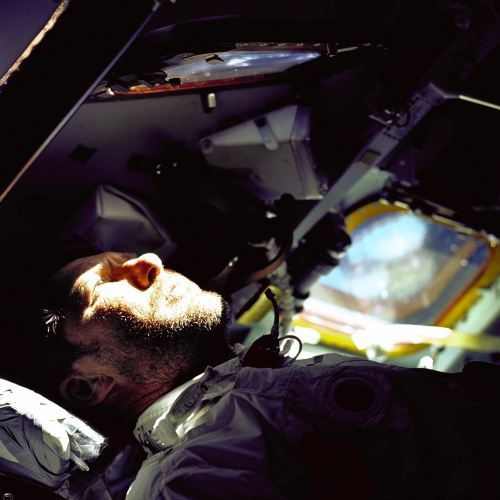Man and space: after the disaster
 In the dark picture, a man, in profile, looks out of the window, blinded by bright light. On the face is a long dark bristle, almost a beard. He is not a criminal, lying at the bottom of a roadside hotel and watching the parking lot. He is an astronaut. This is clear from the window that is in the picture above. The location of zippers and pockets on a white jacket is unusual. On his neck is a microphone, which can usually be seen in call centers. In the background is another window, from a different angle. (We are in the command compartment, the walls here are concave.) It can be seen that the glass is very thick and framed with a bright yellow sealant.
In the dark picture, a man, in profile, looks out of the window, blinded by bright light. On the face is a long dark bristle, almost a beard. He is not a criminal, lying at the bottom of a roadside hotel and watching the parking lot. He is an astronaut. This is clear from the window that is in the picture above. The location of zippers and pockets on a white jacket is unusual. On his neck is a microphone, which can usually be seen in call centers. In the background is another window, from a different angle. (We are in the command compartment, the walls here are concave.) It can be seen that the glass is very thick and framed with a bright yellow sealant.The first thing that catches your eye is the excellent picture quality. Even at maximum magnification, sharpness is not lost, there is almost no noise. With such a contrast of dark areas with bright light, it is difficult to set the correct exposure, but the photographer still managed to capture a wide range of tones, slightly overexposing the astronaut's face. The colors of the film “Kodakhrom” fascinate. The darkness consists of gleaming purple hues and takes up most of the image. The man’s name is Walter Schirra.
Our attention is switched to his face - gloomy, wary, with a shadow of hopelessness. Just like the face of my father driving in the predawn darkness: we are going somewhere, he is silent and does not look at me. I see his face a little bit lower, he thinks of something detached.
You may note that Shirra does not smile. On his face there is not a drop of joy or optimism, which astronauts usually try to portray in front of the camera. In almost all space portraits, we see only positive emotions. Here is one astronaut, despite the complexity of the mission, fooling around in zero gravity. Here is another one looking at our planet from above - and we immediately feel hope for a bright future, that someday people will forget about their personal interests and live in peace and harmony.
')
But this photo is not like that. On it, the astronaut seems to be a navigator who has survived thousands of storms, as if Odysseus or Captain Ahab: he is wounded, obsessed, merciless, and determined. And under the seat he may well lie an open bottle of bourbon. And he seems to be getting enough sleep regularly.
Apollo 7 is the third and final mission of this astronaut. Shirra is the only one who participated in three programs: “Mercury”, “Gemini” and “Apollo”. During this flight, he had caught a cold right in orbit, became irritable and spoke rudely to two other crew members and the mission control center. His mood was transferred to the rest, the atmosphere in the command compartment heated up. This picture was taken the day before the end of the 10-day mission.
Apollo 7 is the first manned flight after the Apollo 1 crash. Then, on January 27, 1967, while preparing for the flight in the command compartment, Gus Grissom, Ed White and Roger Chuffey were burnt alive. Thanks to high pressure and pure oxygen instead of ordinary air, everything - from “stickies” to aluminum - instantly became flammable. Astronauts warned of the risk of fire and complained that the hatch, which opened inwards, did not give in when the pressure inside the ship was higher than outside. On January 27, Shirra was on the backup crew. After one of the past tests, he said: "At first glance, the ship is fine, but still it makes me uneasy."
On the day of the disaster, rescuers opened the hatch in five minutes. The NASA report states: "The specialists who opened the hatches failed to find the crew members." When the smoke cleared, firefighters found astronauts. Their spacesuits and oxygen masks melted so much that it only took an hour and a half to separate the bodies from the cabin.
Source: https://habr.com/ru/post/374569/
All Articles